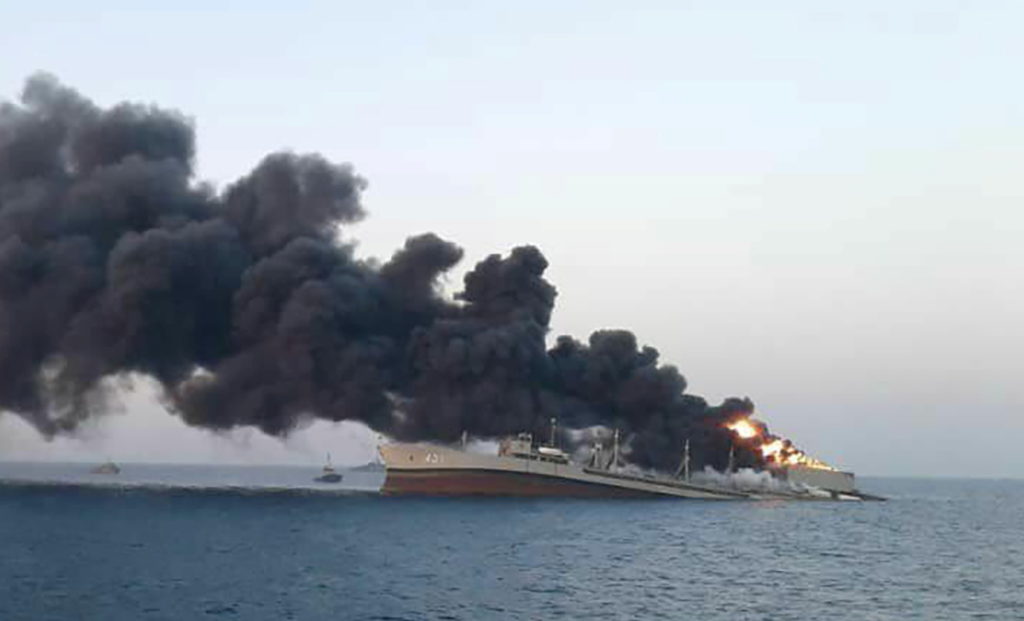June 25, 2021

Iran’s second largest Navy ship, Kharg, sank June 2 after catching fire in the Gulf of Oman, but the crew were all rescued, Iranian media reported.
No further explanation was given for the latest incident, where there have been accusations of attacks on ships owned by arch-enemies Iran and Israel.
The Mehr news agency said the fire started in the engine room, indicating the damage was not due to any external attack.
The Navy simply said the cause of the blaze was under investigation, which will be difficult given that the ship is now on the ocean floor.
State TV said the fire started near the port of Jask, where the ship was on a training mission.
“All efforts to save the vessel were unsuccessful and it sank,” the Fars news agency reported.
In April, Iran said one of its naval vessels, the Saviz, had been targeted in the Red Sea, after media reports the ship had been attacked with limpet mines.
That came after Israel and Iran had reported a series of attacks on each other’s cargo ships since late February.
None of the ships was seriously damaged. Almost all just went about their business. The attacks, all above the waterline, seemed to be more in the nature of harassment. If the Kharg incident was an attack, it would, therefore, represent a huge escalation. But the damage may have been caused by incompetence and ineptitude in fighting a ship fire.
The New York Times said, “It may not be easy to distinguish clumsiness from obfuscation. Iran played down Israeli involvement in recent attacks in an effort to lower tensions and avoid acknowledging Israel’s successes, blaming instead internal sabotage.”
An acknowledgement by Iran that the damage was caused by Israel would put pressure on Iran to retaliate.
Sanam Vakil, deputy director of the Middle East and North Africa Program at Chatham House in London, told The New York Times, “Obviously, the thing we’re all looking for is if the Israelis are involved. The Israeli security establishment is using this period to define some new red lines vis-a-vis Iran and really demonstrate their capacity.”
Israel, she added, has been sending a message to the United States and the region that it is “willing to act independently in order to protect its security interests.”
“It’s bad if it’s their [Iran’s] own fault, and it’s bad if the Israelis are behind it,” Ms. Vakil said. “It’s embarrassing either way. So, the question is: How are they [Iran] going to spin this?”
The ship’s crew tried to contain the fire, but their efforts over 20 hours failed to save the 207-meter (679-foot) Kharg. State media reported 400 sailors and trainee cadets on board fled the vessel, with 33 suffering injuries. About half those on board were trainees.
Like much of Iran’s major military hardware, the Kharg dated back to before the 1979 Islamic revolution. The ship, built in Britain on an order from the Shah, was launched in 1977. But it did not enter the Iranian Navy until 1984 after lengthy negotiations.
The Kharg was not a warship, although Iran often called it a helicopter carrier because it has three helicopters aboard. But many ships carry helicopters nowadays. The Kharg’s job was to handle both refueling and replenishing of ships at sea, said Mike Connell of the Center for Naval Analysis, an Arlington, Virginia-based federally funded nonprofit that works for the US government.
“For the regular Iranian Navy, this vessel was very valuable because it gave them reach,” Connell told The Associated Press. “That allowed them to conduct operations far afield. They do have other logistics vessels, but the Kharg was kind of the most capable and the largest.”
The Kharg was the Iranian Navy’s largest ship until January. The Kharg displaces 33,000 tons. The new ship Makran displaces 121,000 tons.
The sinking of the Kharg marks the latest naval disaster for Iran. In 2020, during an Iranian military training exercise, an Iranian missile mistakenly struck an Iranian naval vessel near Jask, killing 19 sailors and wounding 15. In 2018, a brand new destroyer sank in the Caspian Sea as it was trying to dock.






















